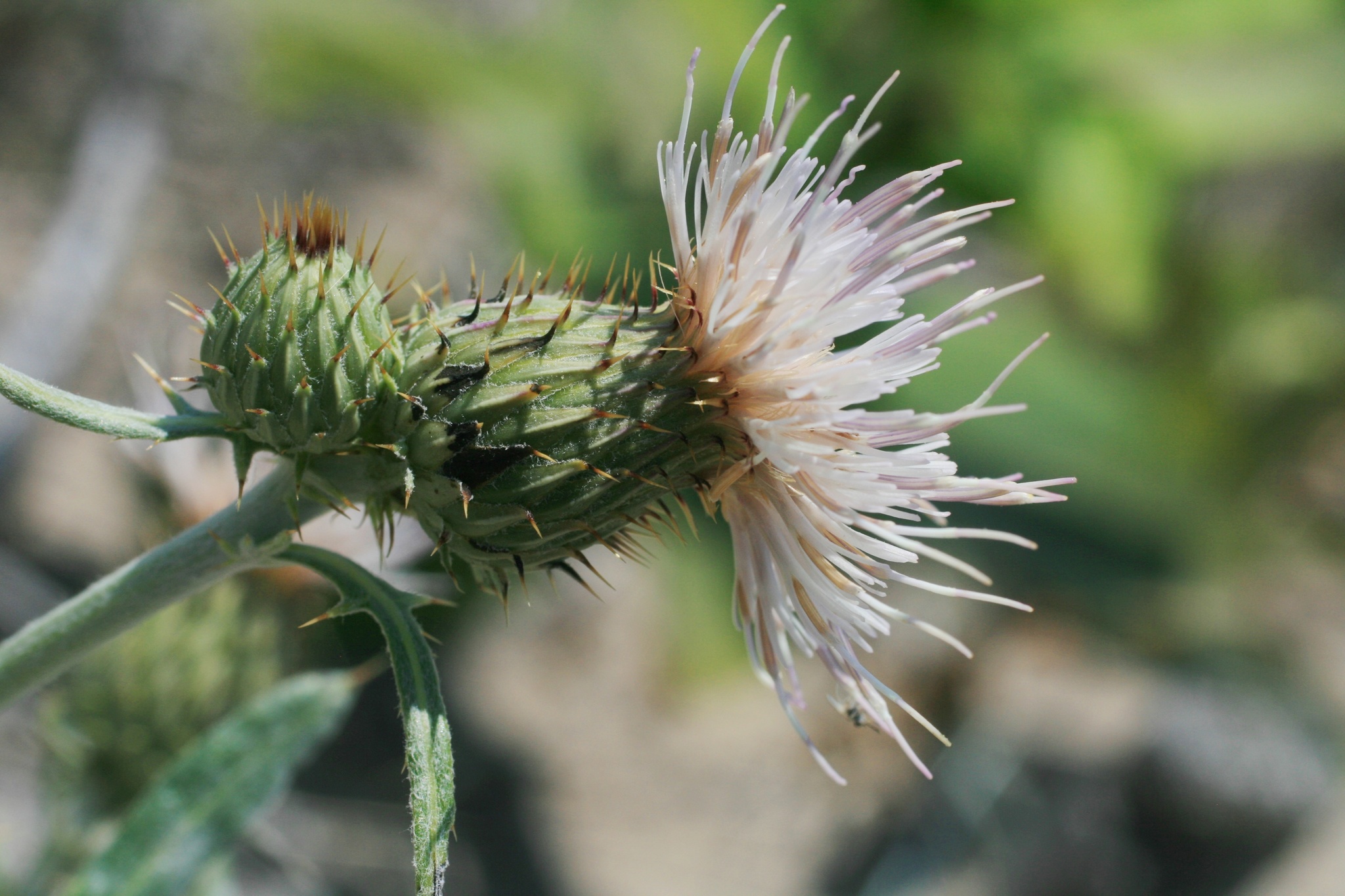Pitcher’s Thistle

Photo credit: © Brian Popelier CC BY-NC 4.0
Species information
The following is a report on progress made towards the protection and recovery of Pitcher’s Thistle (Cirsium pitcheri) in Ontario, from 2007 to 2018, based on species-specific policy. This meets the legislative requirement for a review of progress under the Endangered Species Act, 2007 (ESA or “the Act”). Pitcher’s Thistle is listed as threatened on the Species at Risk in Ontario (SARO) List under the ESA.
Pitcher’s Thistle has been classified as a species at risk in Ontario, since 2004. It was originally classified as an endangered species (in 2004) and retained its ‘endangered’ status under the ESA, when it came into force in June 2008. Based on a re-assessment by the Committee on the Status of Species at Risk in Ontario (COSSARO) in 2011, the species was down-listed to ‘threatened’ in 2011.
First as an endangered species and then as a threatened species, Pitcher’s Thistle has been protected from being killed, harmed, harassed, captured, or taken, under the ESA, since 2008.
In addition, the habitat of Pitcher’s Thistle was protected from being damaged or destroyed from 2011 to 2015, based on the general definition of habitat in the ESA. Since 2015, Pitcher’s Thistle habitat has been protected through a habitat regulation.
In 2015, the government developed a habitat regulation (Ontario Regulation 242/08, section 28.3) for Pitcher’s Thistle, to identify specific areas which would be protected as the species’ habitat (known as regulated habitat). Regulated habitat includes areas required by the species to carry out its life processes (e.g., respiration, growth, reproduction) within its range in Ontario. The habitat regulation was developed based on the habitat needs of the species, as well as social and economic factors, collected from a variety of sources, including comments received through public consultation.
The species-specific policy for Pitcher’s Thistle, known as the Government Response Statement (GRS), was published in 2014, and includes the government’s recovery goal for the species, and the actions and priorities it leads or supports to help achieve that goal. The GRS considers science advice provided in the recovery strategy, when developing recovery actions for the species. As legislated in the Act, the purpose of this Review is to report on progress made towards implementing the protection and recovery actions in the GRS. The Review can also help identify opportunities to adjust and adapt the implementation of protection and recovery actions to achieve the recovery goal for the species.
Further information about Pitcher’s Thistle, including the threats that it faces, and actions being taken to help protect and recover this species is available on Government of Ontario webpage for Pitcher’s Thistle. A summary of progress towards the protection and recovery of Pitcher’s Thistle, and an annual update on the species at risk program, are available on the Review of Progress towards the Protection and Recovery of Ontario’s Species at Risk webpage.
Snapshot
Progress towards the protection and recovery of Pitcher’s Thistle
- The recovery goal for Pitcher’s Thistle in Ontario, as stated in the Government Response Statement (GRS), is to “maintain the current distribution and abundance of the Ontario population and enable natural population increases.”
- Progress has been made towards implementing all government-led actions listed in the GRS. Progress has also been made towards achieving all government-supported recovery objectives, and implementing all associated actions. Examples of progress include:
- Annual inventorying and monitoring of populations at Pinery Provincial Park and installation of boardwalks and signage to identify designated routes to the beach to prevent trampling and dune erosion
- Removing invasive plant species (for example, Phragmites (European Common Reed) (Phragmites australis ssp. australis)) that threaten the survival of Pitcher’s Thistle
- Developing and distributing best management practices (BMPs) on ways to manage dunes for the benefit of Pitcher’s Thistle
- In alignment with the GRS, continued effort to remove invasive species is needed at sites where Phragmites presents a threat to the Pitcher’s Thistle, and implementation of BMPs to prevent trampling of Pitcher’s Thistle and erosion of dunes by redirecting all-terrain vehicle use and pedestrian trails away from Pitcher’s Thistle habitat.
Occurrence and distribution
- Thirty-seven populations
footnote 1 of Pitcher’s Thistle have been documented in Ontario, specifically in the Manitoulin Island area, along the Lake Huron shoreline south of the Bruce Peninsula, and along the Lake Superior shoreline. Currently, 33 of these populations are extant, one is considered historicalfootnote 2 , and three are considered extirpated. - Since 2008, the status of one population changed from extant to historical based on the date that it was last observed. Six populations of Pitcher’s Thistle have been newly identified in Ontario since 2008.
Government-supported stewardship projects
- Through the Species at Risk Stewardship Program, the Government of Ontario has enabled its stewardship partners to conduct six projects ($163,633) that have supported the protection and recovery of multiple species at risk, including Pitcher’s Thistle.
- The government’s support helped its stewardship partners to involve 202 individuals who volunteered 3,220 hours of their time towards protection and recovery activities for species at risk, including Pitcher’s Thistle. The estimated value of these voluntary contributions, as well as additional funding and in-kind support, is $207,526.
- Stewardship partners reported that through their actions 312 hectares of habitat were enhanced for Pitcher’s Thistle and other species at risk that inhabit the same ecosystem.
- Stewardship partners reported providing outreach on multiple species at risk, including Pitcher’s Thistle, to 72,365 individuals.
Supporting human activities while ensuring appropriate support for species recovery
- The Government of Ontario has issued two permits for this species. Of the two permits, one ‘protection or recovery’ permit was issued under clause 17(2)(b) and one ‘overall benefit’ permit was issued under clause 17(2)(c) of the ESA.
Reporting on progress towards the protection and recovery of Pitcher’s Thistle
Recovery Goal
The government's goal for the recovery of Pitcher's Thistle is to maintain the current distribution and abundance of the Ontario population and enable natural population increases.
The implementation of government-led and government-supported actions demonstrates progress towards reaching the desired objectives and the recovery goal set out in the GRS.
Progress towards implementing government-led actions
Progress has been made towards implementing all government-led actions. Common actions for the government to lead as it works toward achieving a species’ recovery goal include:
- Collaborate with federal partners to enable consistency between provincial and federal recovery efforts.
- Educate other agencies and authorities involved in planning and environmental assessment processes on the protection requirements under the ESA.
- Encourage the submission of Pitcher's Thistle data to the government’s central repository at the Natural Heritage Information Centre (NHIC).
- Undertake communications and outreach to increase public awareness of species at risk in Ontario.
- Protect the Pitcher's Thistle and its habitat through the ESA. Develop and enforce the regulation identifying the specific habitat of the species.
- Support conservation, agency, municipal and industry partners, and Indigenous communities and organizations to undertake activities to protect and recover the Pitcher's Thistle. Support will be provided where appropriate through funding, agreements, permits (including conditions) and/or advisory services.
- Establish and communicate annual priority actions for government support in order to encourage collaboration and reduce duplication of efforts.
Additionally, the government has directly undertaken the following species-specific actions:
- Continue to manage for Pitcher's Thistle in provincially protected areas in accordance with management plans. This includes minimizing the threat of recreational pressures and impacts caused by all-terrain vehicles, repairing dune erosion, and constructing boardwalks, stairways, or designated pathways through dunes to reduce the threat of pedestrian trampling of vegetation.
- Conduct inventories for Pitcher's Thistle in provincially protected areas.
Measures to protect Pitcher’s Thistle and its habitat have been undertaken in provincial protected areas, including Pinery Provincial Park. Inventories have been undertaken to monitor plants (for example, numbers of rosettes, flowering individuals or clusters), the suitability of their habitat, and the presence of threats to the species. Rolling boardwalks and traditional elevated boardwalks have been installed, to prevent trampling by pedestrians, and signage has been erected, to indicate designated routes to the beaches.
Key progress made towards the implementation of these actions is described in the following sections.
Ontario’s Invasive Species Act
The GRS for Pitcher’s Thistle indicates that invasive species (for example, Phragmites sp.) pose a threat to the survival and recovery of the species in Ontario. The Ontario Invasive Species Strategic Plan, 2012 and the Invasive Species Act, 2015 provide the policy and legislative framework to support the prevention, detection and control of invasive species in Ontario. This framework may support the implementation of actions to reduce threats from invasive species.
Occurrence and distribution
Thirty-seven populations
Since 2008, the government’s central repository at the Natural Heritage Information Centre (NHIC) has received 2,017 records of the species, based on observations between 1974 and 2018, from a variety of sources. Records submitted have helped to refine where the species is known and has been known to occur, and have provided additional information on the species’ habitat and threats.
Six populations on Manitoulin Island have been newly identified since 2008, including two which were identified based on observations made before 2008 (east of Black Point and Fisher Bay). Based on NHIC records, recent observations (2015 to 2018) have re-confirmed the species at all 33 extant populations. Nine populations are reported to have a good to excellent viability
It is possible that there are observations of Pitcher’s Thistle that have not been submitted to the government. Encouraging the submission of observations of this species is included in the GRS as a government-led action. The submission of species observations increases our knowledge of where they occur, and can play an important role in assessing the viability of species populations.
Everyone is encouraged, or may be required by an authorization or approval to submit observations of Pitcher’s Thistle, and any other species at risk observed, to the NHIC for incorporation into the provincial record of observations. Observations may now be submitted to NHIC via the Rare Species of Ontario project in iNaturalist.
-
2,017observations of this species were submitted to the NHIC since 2008
Government-supported stewardship projects
An important government-led action in the GRS for Pitcher’s Thistle is to support partners to undertake activities to protect and recover the species. Through the Species at Risk Stewardship Program the government has supported six projects designed to contribute to the protection and recovery of Pitcher’s Thistle
Stewardship partners reported that provincial funding helped them to secure in-kind support by involving 202 individuals who volunteered 3,220 hours of their time towards protection and recovery activities for multiple species at risk, including Pitcher’s Thistle, which has an estimated value of $65,590. Partners reported that through both their efforts and those of their volunteers to implement actions contained in the GRS, they were successful in enhancing 312 hectares of habitat that will benefit multiple species at risk, including Pitcher’s Thistle. In addition, stewardship partners reported providing ecosystem-based outreach on multiple species, including Pitcher’s Thistle, to 72,365 individuals.
The remainder of this section highlights two projects supported through the Species at Risk Stewardship Program
From 2015 to 2018, Winter Spider Eco-Consulting and the Manitoulin Phragmites Project implemented two projects to improve habitat for Pitcher's Thistle and 13 other species at risk in shoreline habitats on Manitoulin Island and surrounding islands. As part of a multi-year project, a dedicated field team and over 100 volunteers worked to control the invasive species European Common Reed (Phragmites australis subsp. australis). Through these projects, Phragmites has been controlled or eradicated at 57 sites, including many sites where Pitcher’s Thistle is present. Dump truck loads of Common Reed have been removed from 163 hectares of species at risk habitat, which includes habitat for Pitcher’s Thistle. In addition, standardized monitoring has been conducted for Pitcher's Thistle at 31 sites, which involves collecting abundance data, assessing habitat conditions, and gauging threats to the species and its habitat. These projects support the high priority GRS action to implement BMPs to reduce the threat of invasive species in Pitcher's Thistle habitat. This project also contributes to the GRS action to conduct standardized monitoring where Pitcher’s Thistle is known to occur.
In an earlier project focused on Pitcher's Thistle, Winter Spider Eco-Consulting helped landowners to manage threats to the dune habitat of Pitcher's Thistle on the landowners’ properties. A comprehensive set of BMPs for the protection of Pitcher’s Thistle in Ontario was produced, including information on management of dunes in general, how to identify threats to Pitcher’s Thistle, and ways to address threats. Specific recommendations include redirecting off-road vehicle use and foot traffic, placing structures (e.g., sheds) outside of dune habitat, removing invasive species, preventing damage from wildlife browsing, reducing competing vegetation and changing the perception that thistles are weeds. Some BMPs were implemented, including placement of boulders to protect Pitcher’s Thistle from off-road vehicles and removal of Phragmites. Volunteers were trained to conduct the standardized monitoring protocol and to control European Common Reed. As well, information was shared with local landowners and municipalities on how beaches can be used for recreational activities without destroying Pitcher’s Thistle habitat. This project supported the implementation of multiple GRS actions for Pitcher's Thistle, including:
- The high priority action to develop BMPs on dune conservation that balances succession and disturbances for the benefit of Pitcher’s Thistle;
- The high priority action to implement BMPs to control the threat of invasive species like Phragmites in Pitcher’s Thistle habitat;
- The action to conduct standardized monitoring of known Pitcher’s Thistle occurrences to monitor habitat conditions, determine population dynamics and assess threats; and,
- The action to collaborate with local partners to increase public awareness of the protection and conscientious use of dune habitat.
Species at Risk Stewardship Program
-
 6
6projects included Pitcher's Thistle
-
 $163,633
$163,633for multi-species projects that included Pitcher's Thistle
-
 $207,526
$207,526in additional funding and in-kind support
-
 202
202volunteers
-
 3,220
3,220volunteer hours
-
 72,365
72,365people received outreach
-
 312
312hectares of habitat enhanced
Supporting human activities while ensuring appropriate support for species recovery
Supporting partners through permits and their associated conditions is an important government-led action.
One ‘protection or recovery’ (17(2)(b)) permit has been issued for Pitcher’s Thistle since the species was protected under the ESA. ‘Protection or recovery’ permits are issued if the purpose of the activity is to assist in the protection or recovery of a species at risk. The ‘protection or recovery’ permit was issued for multiple species, including Pitcher’s Thistle. This permit enabled manual pollination treatments and the collection of florets (small flowers that together make the flower head) to determine seed-set, seed mass, viability and percent germination. The permit also enabled seed collection for germination tests to be conducted in laboratory and greenhouse settings.
One ‘overall benefit’ permit was issued exclusively for Pitcher’s Thistle since 2008. Several conditions of the permit were designed to implement government-supported actions identified in the GRS for Pitcher’s Thistle, including:
- Enhancing habitat through removal of invasive species, including European Common Reed, and competing vegetation to increase areas of exposed sand and encourage establishment of new thistles;
- Collecting data on the numbers of seedlings, rosettes and maturing plants present in the activity area; and,
- Monitoring habitat conditions (for example, requirements to georeference and map the patches of Pitcher’s Thistle, take photos and estimate the percentage of vegetation cover and exposed sand).
Other conditions designed to minimize adverse effects included:
- Having a qualified person flag work areas and access routes, to avoid damage to Pitcher’s Thistles and their habitat; and,
- Ensuring machinery is cleaned prior to entering the work site to prevent the spread of invasive plant species.
More detailed information regarding ‘overall benefit’ permits is available through the Environment Registry of Ontario.
No activities that pertain to Pitcher’s Thistle have been registered under Ontario Regulation 242/08 of the ESA.
-
1protection or recovery permit
-
1overall benefit permit
Progress towards implementing government-supported actions
Government-supported actions are organized under overarching recovery objectives. Progress has been made towards achieving all government-supported recovery objectives, and implementing all associated actions that are identified in the GRS for Pitcher’s Thistle.
Objective: Engage landowners, land managers, and Indigenous communities in site stewardship to manage threats and protect Pitcher's Thistle habitat.
- Action No. 1 (High Priority) – Continue to develop and distribute BMPs for landowners, land managers, and Indigenous communities to manage dunes in a manner that balances succession and disturbances for the benefit of the Pitcher's Thistle. Examples of existing practices include:
- creating designated walkways or access routes, and installing boardwalks and rail-post fencing around dunes to control and reduce the threat of pedestrian trampling and all-terrain vehicles
- ensuring that recreational activities and the construction of recreational structures do not occur on dune slopes
- refraining from adding or removing soil in and around dunes
- Action No. 2 (High Priority) – Implement BMPs, such as the government’s Invasive Phragmites BMPs, to control and reduce the threat of invasive species like Phragmites in Pitcher's Thistle habitat.
Under this objective, considerable progress has been made towards implementing both actions, through several projects supported by the Species at Risk Stewardship Program. As part of a community conservation project, a stewardship partner constructed a boardwalk/viewing platform for the Old Ausable Channel, and completed a Draft Community-based Biodiversity Strategy for the Port Franks Area. The strategy included BMPs to support landowners in making landscaping plans for their properties and recommendations for the broader study area to protect coastal dune ecosystems and habitat for rare plants such as Pitcher’s Thistle. Recommended actions included directing development and recreational activities away from sensitive areas, through the use of boardwalks, restricting vehicle access, not disturbing native dune vegetation, and monitoring for invasive plant species.
Another stewardship partner developed BMPs specific to the protection of Pitcher’s Thistle. The recommended actions included prevention/ reduction of damage to dunes by all-terrain vehicles and the trampling of plants by foot traffic, placement of new structures outside of sensitive areas, removal of invasive species and competing vegetation, and prevention of damage by browsing wildlife. This partner also implemented Action No. 2 by completing two years of extensive invasive species removal at over 50 sites along the south shore of Manitoulin Island, including in areas where Pitcher’s Thistle is known to occur.
Objective: Increase knowledge of Pitcher's Thistle population trends, biology, habitat, and threats.
- Action No. 3 – Conduct standardized monitoring at all sites of known occurrences to:
- monitor habitat conditions
- determine population dynamics (for example, trends in population abundance and distribution)
- assess threats to Pitcher's Thistle and its habitat
Standardized monitoring was undertaken by a stewardship partner while field crews were removing invasive species from Pitcher’s Thistle habitat, and sharing BMPs with landowners on how to protect dune habitat for the benefit of Pitcher’s Thistle. The field crews followed a standardized monitoring protocol to document their observations.
Objective: Increase public awareness about threats to Pitcher's Thistle and its habitat.
- Action No. 4 – Collaborate with local partners such as Indigenous communities and organizations, stewardship councils, fish and game clubs and other interest groups to develop communications that promote public awareness of the protection and conscientious use of dune habitat.
This action was implemented through a project supported by the Species at Risk Stewardship Program. A stewardship partner hosted educational events in Grand Bend and the Old Ausable Channel to share information with the public on rare plants and species at risk in the area, and on how to protect dune habitat from the impacts of recreational activities.
Summary of progress towards meeting the recovery goal
The recovery goal for Pitcher’s Thistle is to “maintain the current distribution and abundance of the Ontario population and enable natural population increases”. Effort made towards implementing government-led and government-supported actions has contributed to progress towards this goal. The provincial record of observations shows that new populations have been discovered on Manitoulin Island and surrounding islands, and that the number of individuals has increased at some locations. Additionally, several of the extant 33 populations are also thought to have good-excellent viability, a factor which is likely to contribute to natural population increases. Considerable effort has been made to protect and restore Pitcher’s Thistle habitat, in an effort to support existing populations, including removing invasive plant species, and developing and distributing BMPs. Work has also included inventorying and monitoring Pitcher’s Thistle populations
Recommendations
As stated in the GRS, this Review of Progress can be used to help identify whether adjustments to the implementation of GRS actions are needed, to achieve protection and recovery of the species. Based on progress to date, the overall direction provided in the GRS for Pitcher’s Thistle, particularly the implementation of actions identified as high priority, should continue to guide protection and recovery of the species.
Although varying levels of progress have been made towards implementing all of the GRS actions for Pitcher’s Thistle, further work is needed to fully implement these actions and contribute to the ongoing protection and recovery of this species. For example, while progress has been made to maintain the current distribution of the species, further effort is required to enable natural population increases. Similarly, although considerable progress has been made towards reducing the threat of invasive species, particularly European Common Reed, further work on this action is needed, due to the high rate at which this invasive species spreads.
Protecting and recovering Pitcher’s Thistle will continue to be a shared responsibility that will require the involvement of many individuals, organizations, and communities. Financial support for the implementation of actions may be available through the Species at Risk Stewardship Program. The government can also advise if any authorizations under the ESA or other legislation may be required to undertake a project. By working together, we can continue to make progress towards protecting and recovering Pitcher’s Thistle in Ontario.
References
Committee on the Status of Species at Risk in Ontario (COSSARO). 2011. Ontario Species at Risk Evaluation Report for Pitcher’s Thistle (Cirsium pitcheri). February 2011.
Footnotes
- footnote[1] Back to paragraph For the purposes of this report, a population is defined as an area of land and/or water on/in which an element (e.g., Pitcher’s Thistle) is or was present. They are comprised of one or more observations and the area has a practical conservation value as it is important to the conservation of the species the area has a practical conservation value as it is important to the conservation of the species. An element occurrence is the technical term used to describe this.
- footnote[2] Back to paragraph A population is considered historical if it has not been recorded within the last 20 years. Historical populations may still exist, but updated information is not available.
- footnote[3] Back to paragraph Viability is defined as the probability that a population/occurrence will persist based on its size (including population size and/or occupied area), environmental conditions, and landscape context.
- footnote[4] Back to paragraph Some projects supported through the Species at Risk Stewardship Program may require a 17(2)(b) permit in order to carry out the project. As a result, some 17(2)(b) permits included in this report may have been issued to authorize those projects